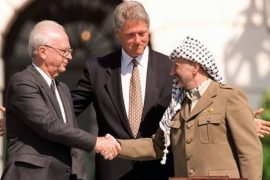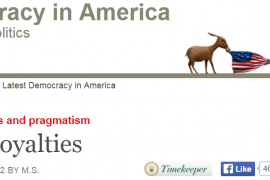An Economist article (“The Palestinians need new leaders”, May 11) begins with context-free and misleading description of an Israeli checkpoint:
Few experiences are more humiliating for Palestinians than plodding through the Israeli checkpoint at Qalandiya, where the West Bank’s administrative headquarters at Ramallah are separated from the Palestinians’ would-be capital in east Jerusalem. Young Israeli conscripts bark orders at middle-aged labourers queuing to cross.
First, readers aren’t told why there’s a checkpoint at that location. It was a response to the countless terror attacks, including suicide bombings, emanating from that part of the West Bank beginning in the 2nd Intifada, rather than some arbitrary decision by authorities to make Palestinians lives miserable.
Further, in 2019 the original Qalandiya checkpoint, which was, by all accounts, inadequate, closed down and was replaced by a technically advanced and larger facility with 27 automatic gates that electronically read biometric permits – similar to those used at airports. “It used to take about an hour to pass through the old one”, said a Palestinian worker quoted in a Times of Israel story about the new checkpoint. “Now”, he added, “it only takes a few minutes, which means that I get about an extra hour of sleep.”
It’s also unclear if the Economist journalist actually witnessed “young Israeli conscripts bark[ing] orders at middle-aged labourers”, as the Times of Israel story reported that, in the new facility, IDF soldiers and private security guards now merely observe the Palestinians from a distance.
New high-tech Jerusalem checkpoint scanning 4,000 people a day: When Palestinians cross a border checkpoint into Jerusalem, they go through the new Qalandiya station — an upgraded passage point Israel hopes will cut out the long lines and poor… https://t.co/AXFnhouhcz pic.twitter.com/PwWLsYayWG
— Patrick (@cahulaan) July 11, 2019
The Economist article continues:
Meanwhile the Palestinian workers can hear the roar of Israeli commuters who live in settlements on nearby Palestinian land zooming along a four-lane motorway barred to Palestinians, en route to jobs in Tel Aviv.
This is misleading.
While it’s not clear which motorway their referring to (though it may be a 3.2 km stretch of road known as Route 45), according even to B’tselem, the overwhelming majority of West Bank roads are open to Palestinians as well as Israelis. No more than 40 km of West Bank roads – a tiny fraction of the total – are, for security reasons, prohibited to Palestinian drivers. It should be noted that – belying the charge of ‘apartheid’ – east Jerusalem Palestinian residents, Arab Israelis and foreign visitors are permitted on these restricted roads.
The deception continues:
Seventy-five years after the UN voted to divide Palestine into an Arab and a Jewish state, Palestinians are still waiting for one.
The Arab and Palestinian leadership rejected the UN Partition Plan of 1947 that would have created a Palestinian state alongside a Jewish one. Jewish leaders accepted it. The Arabs waged a war of annihilation against the nascent Jewish state on the day of its birth, in May 1948, and lost.
The Arabs launched another war of annihilation against Israel in June of 1967, and lost.
In 2000, 2001 and 2008, Palestinians leaders rejected Israeli peace offers that would have created a Palestinian state. (After rejecting the Israeli peace offer in July of 2000, Palestinian leaders launched the 2nd Intifada, a five year campaign of savage violence targeting civilians which traumatised a generation of Israelis.)
This is in part why the Palestinians are “still waiting” for a state.
The article continues:
Israel now rules over 7m Palestinians, including those in Israel and in the West Bank and the Gaza Strip, which are internationally regarded as the basis of an independent Palestinian state. Another 7m are strewn across the Arab world and beyond, about half registered as refugees (see map). Palestinians are a slight overall majority in the territories controlled by Israel and in Israel proper. But they are divided over how to build a future.
This narrative is straight out of the B’tselem apartheid libel, which CAMERA refuted here.
First, to maintain that Israel rules over 7 million Palestinians is to absurdly suggest that Jerusalem rules over Gaza. It also – in a disgraceful rhetorical slight of hand – includes, as those “Palestinians” being “ruled” by Israel, Arab citizens of Israel. But, of course they’re being “ruled” by Israel, as they’re citizens of the state! For that matter, seven million Jews are being “ruled” by Israel.
Here’s the map the Economist used to illustrate the author’s point, which, as you can see, makes no effort to distinguish between the 1.7 million Arab citizens of Israel (which they call simply Palestinians) and Palestinians in Gaza, the West Bank and elsewhere.

Continuing with the lie by omission about why there’s no Palestinian state in previous paragraphs, the article then provides the following context:
At times statehood has beckoned. In 1993 Israel and the Palestinian Liberation Organisation (plo), the Palestinians’ representative body, signed the Oslo accords that provided for Palestinian self-rule in Gaza and the West Bank under a Palestinian National Authority (pa) and an end to Israel’s occupation within five years. It never happened.
First, the Oslo Accords never called for the creation of a Palestinian state, despite the fact that the process resulted in Israeli leaders offering Palestinian leaders just that. Further, contrary to the suggestion in the text, Palestinians do of course have self-rule in Gaza, and (more limited) self-rule in Area A of the West Bank, which includes the major Palestinian population centers.
Later in the piece, the writer seems to have forgotten that he or she maintained that Israel “rules” Gaza.
Hamas, an armed Palestinian Islamist movement, won a general election in 2005 and set up a separate administration in Gaza, leaving an enfeebled pa to run bits of the West Bank.
Which is it? Does Hamas or Jerusalem administer Gaza?
The distortions and lies continue:
America’s Congress, viewing the PA as an instrument of terrorism, have long been loth to fund it.
In fact, the US, under President Biden, has given hundreds of millions of dollars a year to the Palestinians.
Then, we’re told the following:
A new intifada, or uprising, could erupt. Last year’s West Bank death toll from violence was the highest since the end of the previous deadly intifada in 2004. This year’s rate so far has been higher.
As our data proves, the overwhelming majority of Palestinian fatalities in 2022-23 were terrorists or males involved with violent clashes, while the overwhelming majority of Israelis killed during this time were civilians.
Then, there’s another lie:
Israel controls [Gaza’s] borders, sea and air space so its 2.2m people feel besieged, as if in an open-air prison.
Egypt, as they no doubt know, controls Gaza’s southern border, not Israel. Also, as we noted previously, there were over 672,000 Palestinian crossings last year from Gaza into Israel – for work, medical care or other humanitarian reasons. Thousands more leave the territory every year via Egypt’s Rafa crossing.
This is among the sloppiest Israel-related articles we’ve ever read at the Economist, and we’ve complained to editors asking that the counter-factual claims be corrected.





